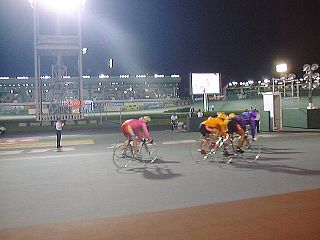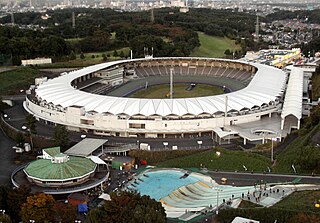 W
WAomori Velodrome , also known as Jomon Bank Aomori Velodrome, is a velodrome located in Aomori City that conducts pari-mutuel Keirin racing - one of Japan's four authorized "Public Sports" where gambling is permitted. Its Keirin identification number for betting purposes is 12#.
 W
WChiba Velodrome is a velodrome located in Chiba City that conducts pari-mutuel Keirin racing - one of Japan's four authorized "Public Sports" where gambling is permitted. Its Keirin identification number for betting purposes is 32#.
 W
WIwaki-Taira Velodrome is a velodrome located in Iwaki, Fukushima that conducts pari-mutuel Keirin racing - one of Japan's four authorized "Public Sports" where gambling is permitted. Its Keirin identification number for betting purposes is 13#.
 W
WKagetsu-en Velodrome was a velodrome located in Yokohama that conducted pari-mutuel Keirin racing - one of Japan's four authorized "Public Sports" where gambling is permitted.
 W
WKawasaki Velodrome is a velodrome located in Kawasaki, Kanagawa that conducts pari-mutuel Keirin racing - one of Japan's four authorized "Public Sports" where gambling is permitted. Its Keirin identification number for betting purposes is 34#.
 W
WKeiokaku Velodrome , also known as TOKYO OVAL KEIOKAKU, is a velodrome located in Chōfu, Tokyo that conducts pari-mutuel Keirin racing - one of Japan's four authorized "Public Sports" where gambling is permitted. Its Keirin identification number for betting purposes is 27#.
 W
WKeirin – literally "racing cycle" – is a form of motor-paced cycle racing in which track cyclists sprint for victory following a speed-controlled start behind a motorized or non-motorized pacer. It was developed in Japan around 1948 for gambling purposes and became an official event at the 2000 Olympics in Sydney, Australia.
 W
WMatsudo Velodrome is a velodrome located in Matsudo, Chiba that conducts pari-mutuel Keirin racing - one of Japan's four authorized "Public Sports" where gambling is permitted. Its Keirin identification number for betting purposes is 31#.
 W
WMisato Rokugo Velodrome is a velodrome located in Misato, Akita. Rokugo's oval is 333 meters in circumference.
 W
WŌmiya Velodrome is a velodrome located in Ōmiya-ku, Saitama that conducts pari-mutuel Keirin racing - one of Japan's four authorized "Public Sports" where gambling is permitted. Its Keirin identification number for betting purposes is 25#.
 W
WSeibu-en Velodrome is a velodrome located in Tokorozawa, Saitama that conducts pari-mutuel Keirin racing - one of Japan's four authorized "Public Sports" where gambling is permitted. Its Keirin identification number for betting purposes is 26#.
 W
WTachikawa Velodrome is a velodrome located in Tachikawa, Tokyo that conducts pari-mutuel Keirin racing - one of Japan's four authorized "Public Sports" where gambling is permitted. Its Keirin identification number for betting purposes is 28#.
 W
WToride Velodrome is a velodrome located in Toride, Ibaraki, that conducts pari-mutuel keirin racing - one of Japan's four authorized "public sports" where gambling is permitted. Its keirin identification number for betting purposes is 23#.
 W
WUtsunomiya Velodrome is a velodrome located in Utsunomiya, Tochigi that conducts pari-mutuel Keirin racing - one of Japan's four authorized "Public Sports" where gambling is permitted. Nicknamed "Kaze no Wonderland" , its Keirin identification number for betting purposes is 24#.
 W
WYahiko Velodrome is a velodrome located in Yahiko, Niigata that conducts pari-mutuel Keirin racing - one of Japan's four authorized "Public Sports" where gambling is permitted. Its Keirin identification number for betting purposes is 21#.
 W
WYamada Green Dome Maebashi is an arena in Maebashi, Japan. With a capacity of 8,000, it is primarily used for indoor sports. One of its primary functions is as a velodrome - when it is known as Maebashi Velodrome - holding parimutuel Keirin races throughout the year.
 W
WYowamushi Pedal is a Japanese manga series written and illustrated by Wataru Watanabe. It began serialization in the 12th issue of Akita Shoten’s Weekly Shōnen Champion in 2008, and as of February 2020, the series has been compiled into 68 tankōbon volumes. An anime television series adaptation aired from October 2013 to July 2014, followed by a second season aired from October 2014 to March 2015, a third season aired from January to June 2017 and a fourth season aired from January to June 2018. A live-action television drama adaptation aired in August 2016. A live-action film adaptation is set to release in August 2020.